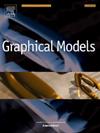Quasi-interpolation projectors for subdivision function spaces
IF 2.2
4区 计算机科学
Q2 COMPUTER SCIENCE, SOFTWARE ENGINEERING
引用次数: 0
Abstract
Subdivision surfaces as an extension of splines have become a promising technique for addressing PDEs on models with complex topologies in isogeometric analysis. This has sparked interest in exploring the approximation by subdivision function spaces. Quasi-interpolation serves as a significant tool in the field of approximation, offering benefits such as low computational expense and strong numerical stability. In this paper, we propose a straightforward approach for constructing the quasi-interpolation projectors of subdivision function spaces that features explicit formulations and achieves a highly desirable approximation order. The local interpolation problem is constructed based on the subdivision mask and the limit position mask, overcoming the cumbersome evaluation of the subdivision basis functions and the difficulty associated with deriving explicit solutions to the problem. Explicit quasi-interpolation formulas for the loop, modified loop, and Catmull–Clark subdivisions are provided. Numerical experiments demonstrate that these quasi-interpolation projectors achieve an expected approximate order and present promising prospects in isogeometric collocation.

细分函数空间的准插值投影
细分曲面作为样条的延伸,在等几何分析中已成为求解复杂拓扑模型偏微分方程的一种有前途的技术。这激发了人们对通过细分函数空间来探索近似的兴趣。准插值是逼近领域的重要工具,具有计算费用低、数值稳定性强等优点。在本文中,我们提出了一种构造细分函数空间的拟插值投影的简单方法,该方法具有明确的公式并达到了非常理想的近似阶。基于细分掩码和极限位置掩码构造了局部插值问题,克服了细分基函数求值的繁琐和求显式解的困难。给出了环、修正环和Catmull-Clark细分的显式拟插值公式。数值实验表明,这些拟插值投影达到了预期的近似阶数,在等几何配置中具有良好的应用前景。
本文章由计算机程序翻译,如有差异,请以英文原文为准。
求助全文
约1分钟内获得全文
求助全文
来源期刊

Graphical Models
工程技术-计算机:软件工程
CiteScore
3.60
自引率
5.90%
发文量
15
审稿时长
47 days
期刊介绍:
Graphical Models is recognized internationally as a highly rated, top tier journal and is focused on the creation, geometric processing, animation, and visualization of graphical models and on their applications in engineering, science, culture, and entertainment. GMOD provides its readers with thoroughly reviewed and carefully selected papers that disseminate exciting innovations, that teach rigorous theoretical foundations, that propose robust and efficient solutions, or that describe ambitious systems or applications in a variety of topics.
We invite papers in five categories: research (contributions of novel theoretical or practical approaches or solutions), survey (opinionated views of the state-of-the-art and challenges in a specific topic), system (the architecture and implementation details of an innovative architecture for a complete system that supports model/animation design, acquisition, analysis, visualization?), application (description of a novel application of know techniques and evaluation of its impact), or lecture (an elegant and inspiring perspective on previously published results that clarifies them and teaches them in a new way).
GMOD offers its authors an accelerated review, feedback from experts in the field, immediate online publication of accepted papers, no restriction on color and length (when justified by the content) in the online version, and a broad promotion of published papers. A prestigious group of editors selected from among the premier international researchers in their fields oversees the review process.
 求助内容:
求助内容: 应助结果提醒方式:
应助结果提醒方式:


